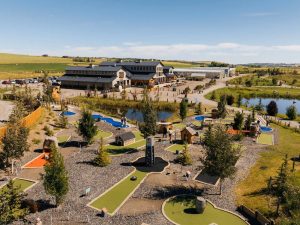Minister promotes rural, western and Indigenous pathways to continued tourism success

Granary Road, about a half-hour by car southwest of Calgary in De Winton, offers markets, festive goat yoga, an active learning park and more. Travel Alberta
By George Lee, Local Journalism Initiative Reporter
Originally Published on Nov 13, 2025 at 11:15
A rich tapestry of western heritage unfolds beyond Alberta’s big cities and more famous destinations, providing amazing opportunities for tourists and rural entrepreneurs alike.
That’s among the key messages offered up by Andrew Boitchenko, who joined cabinet last May as the province’s latest minister of tourism and sport.
Boitchenko told The Macleod Gazette in a recent interview: “Rural Alberta is a chance to show visitors our communities’ connection to our western heritage, so they can actually see it and experience it.”
Traditional farms and ranches are big in Alberta’s story, but there’s much more on offer. Among experiences worth exploring are glamping, hiking and snowshoeing adventures, Indigenous knowledge walks and corporate retreats.
One destination success story Boitchenko points to is Métis Crossing, where visitors can view the stars or the Northern Lights through the tops of glamping-style domes. Made up of river lots intrinsic to the Métis history, the crossing offers programs that include a chance to immerse yourself in a winter trapline experience.
You can join a Métis interpreter on a nature walk along the North Saskatchewan River or experience Métis music and dancing in an up-close and personal way.
Owned by the former Métis Nation of Alberta, which is now called Otipemisiwak Métis Government, the operation near Smoky Lake northeast of Edmonton received a $1-million investment from the province towards a 40-room lodge in 2020.
“It’s an absolutely amazing facility, and people are coming there from across the world,” says Boitchenko, noting that Métis Crossing is representative of a province-wide trend of showcasing Alberta’s Indigenous roots.
Boitchenko’s comments come after the province shed light on $1.7 million in agri-tour support over the past year, funneled through Travel Alberta’s investment program. A Crown corporation since 2009, Travel Alberta bills itself as the province’s destination management organization.
The province aims to use spending and policies to help push the tourism economy to $25 billion by 2035. Boitchenko, the member for Drayton Valley-Devon, calls it “an ambitious goal.”
But he’s confident Alberta will get there and beyond. “We’re well on our way and I am optimistic.”
The tourism economy is a measure of what tourists — whether from Alberta, the rest of Canada or beyond — spend on things like attractions, food, gas and accommodation. Travel Alberta estimates the total at $12.8 billion in 2023 and $14.4 billion last year, saying the province led the nation in year-over-year growth.
With 38 million visitors last year, Alberta is “one of North America’s most exciting frontiers for tourism investment,” boasts the Crown corporation on its website.
Part of that thrust is support for rural projects big and small like boutique hotels, bed-and-breakfasts, petting zoos, corn mazes and glamping sites.
Among them is Chimney Rock Ranch, a retreat in the Porcupine Hills, just off the Cowboy Trail in southern Alberta. Support from the province there is going towards equine, wellness and Indigenous programming.
Granary Road, meanwhile, has expanded to attract about 200,000 visitors a year, thanks to a shift to all-season status with provincial help. Just 10 minutes south of Calgary, the farm-themed park includes a market, mini-golf, play areas and climbing structures, and opportunities to learn about plants and food production.
Provincial tourism-friendly laws and policy are important to the industry’s future, Boitchenko said, pointing to last year’s All-Season Resorts Act. The act, passed in December 2024, creates a classification of public lands for all-season resorts and establishes a new regulator for them.
Skiers are among the new act’s targets. Millions of skiers in Alberta, B.C., Colorado and elsewhere are choosing destination resorts, and Alberta can attract more of them to travel here or ski at home.
With the demands of tourism on infrastructure like highways and airports, spreading tourism through the year as much as possible is important.
“We have shoulder seasons. We have winter seasons. It’s not only summer that people can travel and see these things,” the minister says.
Adventure awaits not only tourists. Boitchenko encourages rural Albertans with an eye to expanding their revenue streams or developing a new business to keep tourism in mind.
Although applications for the investment program have closed for the 2026-27 intake, a good place to start is the Travel Alberta Industry Hub at industry.travelalberta.com.
Travel Alberta offers world-class advice and experience, Boitchenko says.
“My message would be that you get in touch with Travel Alberta. It doesn’t cost you anything,” he says. “There are a lot of tools available in their toolchest.”
